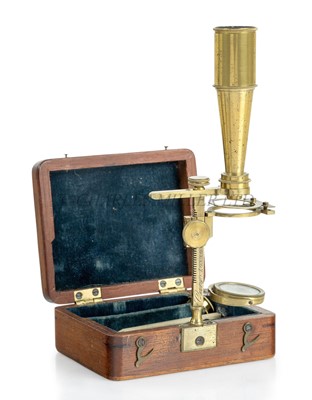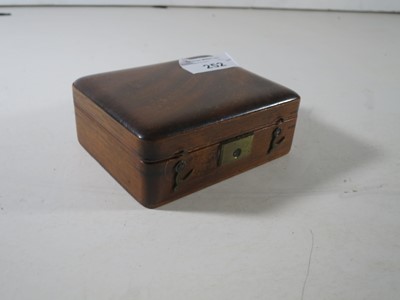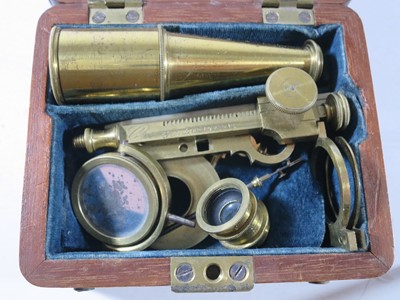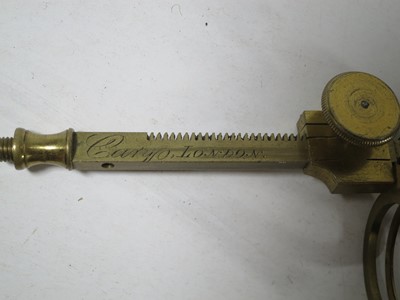14th Nov, 2023 10:00
Maritime and Scientific Models, Instruments & Art (HIGHFLYER)
252
[M] A CARY-GOULD TYPE MICROSCOPE 1820-1850
A GOULD-TYPE BOTANIST MICROSCOPE BY CARY, CIRCA 1830
constructed in lacquered brass and signed on the rack and pinion support, Cary, London, complete with three nose pieces, mirror, platform stage and pincer arm, and contained in plush lined wooden pocket box of issue -- 4in. (10cm.) wide
Dr. Mill notes:
This type of pocket microscope attained enormous popularity in the 1820-1850s and numerous examples exist in museums. William Cary was a noted instrument maker and an apprentice of Jesse Ramsden. Charles Gould who worked for Cary designed this microscope specifically for the amateur naturalist to meet popular demand. It became widely used and was copied by other leading makers. Unfairly it has became known as the Cary Type. This ingeniously uses the case as its stand.
The instrument is tiny, measuring about 17cm high and dismantling quickly to fit into its tiny case ( 96x77x36mm). There are three simple lenses labelled 1,2.3 which can be used singly or (theoretically) in combination. The small stage carries a spring retainer to hold sliders and is mounted on the limb with a rack movement. There is a slightly concave mirror. Accessories include a circular stage plate which may once have carried a small glass plate to form a simple live box. The tapering tube is of the type common at the time to larger microscopes. The limb is engraved with Cary London in this maker's characteristic style. The tube attaches to the limb by a small bar and retaining screw. It is possible to remove this bar from the limb and the tube leaving the lens(es) attached to it.
Everything fits neatly in the small mahogany case lined with blue velvet.
A proud owner has written 'R. F. Whitting' on the bottom
ref: The Great age of the Microscope, Turner, G L'E. p75 seq.
Sold for £558
Estimated at £200 - £300
(inc. buyer's premium of 24%)
Condition Report
good overall condition. Lacking pincer and spike.
We are pleased to provide you with a general report of the condition of this property. Since we are not professional conservators or restorers, we urge you to consult with a restorer or conservator of your choice who will be better able to provide a detailed, professional report. Prospective buyers should inspect each lot to satisfy themselves as to condition and must understand that any statement made by Charles Miller Ltd is merely a subjective, qualified opinion. Prospective buyers should also refer to any Important Notices regarding this sale, which are printed in the Sale Catalogue. NOTWITHSTANDING THIS REPORT OR ANY DISCUSSIONS CONCERNING A LOT, ALL LOTS ARE OFFERED AND SOLD “AS IS” IN ACCORDANCE WITH THE CONDITIONS OF BUSINESS PRINTED IN THE SALE CATALOGUE.
A GOULD-TYPE BOTANIST MICROSCOPE BY CARY, CIRCA 1830
constructed in lacquered brass and signed on the rack and pinion support, Cary, London, complete with three nose pieces, mirror, platform stage and pincer arm, and contained in plush lined wooden pocket box of issue -- 4in. (10cm.) wide
Dr. Mill notes:
This type of pocket microscope attained enormous popularity in the 1820-1850s and numerous examples exist in museums. William Cary was a noted instrument maker and an apprentice of Jesse Ramsden. Charles Gould who worked for Cary designed this microscope specifically for the amateur naturalist to meet popular demand. It became widely used and was copied by other leading makers. Unfairly it has became known as the Cary Type. This ingeniously uses the case as its stand.
The instrument is tiny, measuring about 17cm high and dismantling quickly to fit into its tiny case ( 96x77x36mm). There are three simple lenses labelled 1,2.3 which can be used singly or (theoretically) in combination. The small stage carries a spring retainer to hold sliders and is mounted on the limb with a rack movement. There is a slightly concave mirror. Accessories include a circular stage plate which may once have carried a small glass plate to form a simple live box. The tapering tube is of the type common at the time to larger microscopes. The limb is engraved with Cary London in this maker's characteristic style. The tube attaches to the limb by a small bar and retaining screw. It is possible to remove this bar from the limb and the tube leaving the lens(es) attached to it.
Everything fits neatly in the small mahogany case lined with blue velvet.
A proud owner has written 'R. F. Whitting' on the bottom
ref: The Great age of the Microscope, Turner, G L'E. p75 seq.
Auction: Maritime and Scientific Models, Instruments & Art (HIGHFLYER), 14th Nov, 2023
60
Page turning catalogue here
Downloadable bid form here
Saleroom notice here
PRICE LIST WITH BUYERS PREMIUM HERE
HAMMER PRICE LIST HERE
Order of Sale:
Mercantile Sail 1-41
Mercantile Steam 42-103
Naval Sail 104-163
Naval Steam 164-211
Navigational & Scientific Instruments 214-270
You will not be able to bid in person for this sale, however, there are a number of ways you can still participate:
- Absentee bid – you can place a bid through your account on this website or download a bid form here
- Online via one of the following platforms:
easyliveAuction: 3% surcharge or a flat-rate fee of £3
The Saleroom: 5% surcharge
We regret we are unable to offer telephone bidding for this sale
Shippers
Part & Parcel / shipping@partandparceluk.com / Tel: +44 (0)1252 545611
Alban Shipping / info@albanshipping.co.uk / Tel: +44 (0) 1582 493099
Viewing
From the 30th October by appointment only.
Please call or email to book a slot: Tel: (0)20 7806 5530 or enquiries@charlesmillerltd.com
Viewing at our new address:
300 Munster Road
Fulham
London
SW6 6BH







